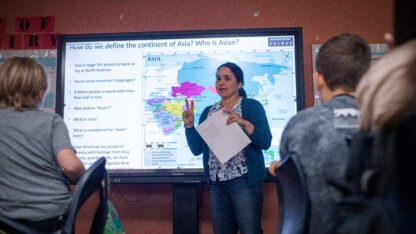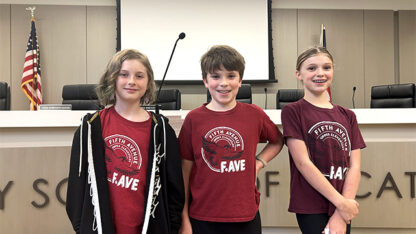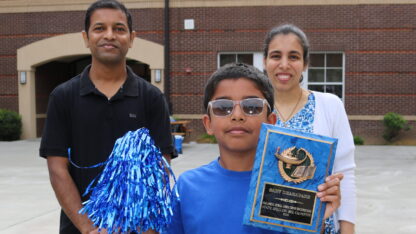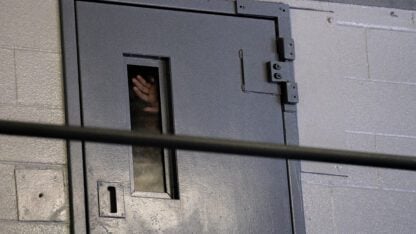Most US students are recovering from pandemic-era setbacks, but millions are making up little ground

On one side of the classroom, students circled teacher Maria Fletcher and practiced vowel sounds. In another corner, children read together from a book. Scattered elsewhere, students sat at laptop computers and got reading help from online tutors.
For the third graders at Mount Vernon Community School in Virginia, it was an ordinary school day. But educators were racing to get students learning more, faster, and to overcome setbacks that have persisted since schools closed for the COVID-19 pandemic four years ago.
America’s schools have started to make progress toward getting students back on track. But improvement has been slow and uneven across geography and economic status, with millions of students — often those from marginalized groups — making up little or no ground.
Nationally, students made up one-third of their pandemic losses in math during the past school year and one-quarter of the losses in reading, according to the Education Recovery Scorecard, an analysis of state and national test scores by researchers at Harvard and Stanford.
But in nine states, including Virginia, reading scores continued to fall during the 2022-23 school year after previous decreases during the pandemic.
Clouding the recovery is a looming financial crisis. States have used some money from the historic $190 billion in federal pandemic relief to help students catch up, but that money runs out later this year.
“The recovery is not finished, and it won’t be finished without state action,” said Thomas Kane, a Harvard economist behind the scorecard. “States need to start planning for what they’re going to do when the federal money runs out in September. And I think few states have actually started that discussion.”
Virginia lawmakers approved an extra $418 million last year to accelerate recovery. Massachusetts officials set aside $3.2 million to provide math tutoring for fourth and eighth grade students who are behind grade level, along with $8 million for literacy tutoring.
But among other states with lagging progress, few said they were changing their strategies or spending more to speed up improvement.
Virginia hired online tutoring companies and gave schools a “playbook” showing how to build effective tutoring programs. Lisa Coons, Virginia’s superintendent of public instruction, said last year’s state test scores were a wake-up call.
“We weren’t recovering as fast as we needed,” Coons said in an interview.
U.S. Education Secretary Miguel Cardona has called for states to continue funding extra academic help for students as the federal money expires.
“We just can’t stop now,” he said at a May 30 conference for education journalists. “The states need to recognize these interventions work. Funding public education does make a difference.”
In Virginia, the Alexandria district received $2.3 million in additional state money to expand tutoring.
At Mount Vernon, where classes are taught in English and Spanish, students are divided into groups and rotate through stations customized to their skill level. Those who need the most help get online tutoring. In Fletcher’s classroom, a handful of students wore headsets and worked with tutors through Ignite Learning, one of the companies hired by the state.
With tutors in high demand, the online option has been a big help, Mount Vernon principal Jennifer Hamilton said.
“That’s something that we just could not provide here,” she said.
Ana Marisela Ventura Moreno said her 9-year-old daughter, Sabrina, benefited significantly from extra reading help last year during second grade, but she’s still catching up.
“She needs to get better. She’s not at the level she should be,” the mother said in Spanish. She noted the school did not offer the tutoring help this year, but she did not know why.
Alexandria education officials say students scoring below proficient or close to that cutoff receive high-intensity tutoring help and they have to prioritize students with the greatest needs. Alexandria trailed the state average on math and reading exams in 2023, but it’s slowly improving.
More worrying to officials are the gaps: Among poorer students at Mount Vernon, just 24% scored proficient in math and 28% hit the mark in reading. That’s far lower than the rates among wealthier students, and the divide is growing wider.
Failing to get students back on track could have serious consequences. The researchers at Harvard and Stanford found communities with higher test scores have higher incomes and lower rates of arrest and incarceration. If pandemic setbacks become permanent, it could follow students for life.
The Education Recovery Scorecard tracks about 30 states, all of which made at least some improvement in math from 2022 to 2023. The states whose reading scores fell in that span, in addition to Virginia, were Nevada, California, South Dakota, Wyoming, Indiana, Oklahoma, Connecticut and Washington.
Only a few states have rebounded to pre-pandemic testing levels. Alabama was the only state where math achievement increased past 2019 levels, while Illinois, Mississippi and Louisiana accomplished that in reading.
In Chicago Public Schools, the average reading score went up by the equivalent of 70% of a grade level from 2022 to 2023. Math gains were less dramatic, with students still behind almost half a grade level compared with 2019. Chicago officials credit the improvement to changes made possible with nearly $3 billion in federal relief.
The district trained hundreds of Chicago residents to work as tutors. Every school building got an interventionist, an educator who focuses on helping struggling students.
The district also used federal money for home visits and expanded arts education in an effort to re-engage students.
“Academic recovery in isolation, just through ‘drill and kill,’ either tutoring or interventions, is not effective,” said Bogdana Chkoumbova, the district’s chief education officer. “Students need to feel engaged.”
At Wells Preparatory Elementary on the city’s South Side, just 3% of students met state reading standards in 2021. Last year, 30% hit the mark. Federal relief allowed the school to hire an interventionist for the first time, and teachers get paid to team up on recovery outside working hours.
In the classroom, the school put a sharper focus on collaboration. Along with academic setbacks, students came back from school closures with lower maturity levels, principal Vincent Izuegbu said. By building lessons around discussion, officials found students took more interest in learning.
“We do not let 10 minutes go by without a teacher giving students the opportunity to engage with the subject,” Izuegbu said. “That’s very, very important in terms of the growth that we’ve seen.”
Olorunkemi Atoyebi was an A student before the pandemic, but after spending fifth grade learning at home, she fell behind. During remote learning, she was nervous about stopping class to ask questions. Before long, math lessons stopped making sense.
When she returned to school, she struggled with multiplication and terms such as “dividend” and “divisor” confused her.
While other students worked in groups, her math teacher took her aside for individual help. Atoyebi learned a rhyming song to help memorize multiplication tables. Over time, it began to click.
“They made me feel more confident in everything,” said Atoyebi, now 14. “My grades started going up. My scores started going up. Everything has felt like I understand it better.”








